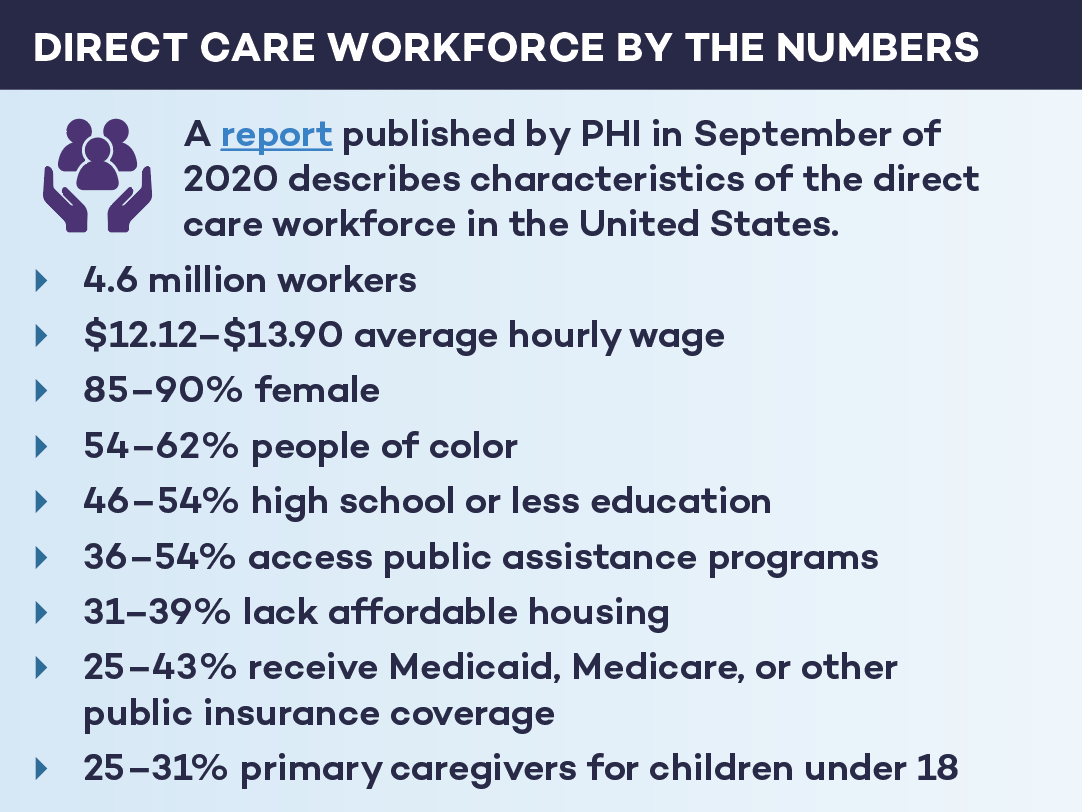This issue brief provides a series of multi-sector state and employer strategies to address recruitment and health sector retention of direct care workers while balancing workforce needs, job quality and wages.
(View/Download Brief | Watch the Webinar)
Introduction
Entry level health care workers represent a critical component of the health care workforce. Although titles and minimum certification requirements vary by state and employer, these individuals, including Certified Nursing Assistants/Aides (CNAs), Home Health Aides (HHAs), Personal Care Aides/Assistants (PCAs), and Direct Support Professionals (DSPs), hereafter referenced as direct care workers, provide hands-on essential services for older adults, individuals with disabilities, and individuals undergoing intensive rehabilitation in facility and home-based settings.

The health care industry has long experienced challenges in recruiting and retaining direct care workers due to low wages, high physical demands and lack of upward mobility. Before the COVID-19 pandemic, in many instances, individuals who might have considered direct care jobs could work in less physically demanding retail positions or other service industry jobs for the same or greater pay. The onset of the COVID-19 pandemic, however, brought with it a surge in demand for direct care workers while other industries experienced significant layoffs and business closures because of physical distancing restrictions and the economic downturn. This confluence of events provides an opportunity for states and employers to focus on strategies to enhance the recruitment and retention of direct care workers.
Ensuring an adequate supply of direct care workers requires multi-sectoral and multi-industry collaboration, including commitments from state and local government, employers and academic institutions. Several states and employers have made great strides in developing strategies to recruit direct care workers into jobs that have pathways toward higher earning and training, allowing for greater economic and career mobility.
This issue brief provides a series of multi-sector state and employer strategies to address recruitment and health sector retention of direct care workers while balancing workforce needs, job quality and wages. It focuses largely on jobs that pay less than or close to 200% of the federal poverty guideline for a household of three in 2021 or $43,920. The strategies have even greater relevance in the wake of the COVID-19 pandemic, but they are intended as longer-term opportunities to address the broader needs of the industry and direct care workers. Many of the considerations are drawn from strategies traditionally leveraged in broad sector-based workforce development planning, such as engaging workforce development boards and creating apprenticeship pathways.
Key Considerations Include:
- Create a platform for cross-sector collaboration: Work across state agencies and with employers and training programs to identify priorities and coordinate direct care workforce development policy.
- Compare, standardize and streamline roles and regulatory requirements for direct care worker positions across state agencies: Consider comparing direct care roles and streamlining requirements to increase professional progression and mobility for direct care workers to develop additional skills and advance in their careers.
- Develop intentional recruitment and retention strategies: Consider pipeline strategies that encourage entry into the direct care workforce and identify and support pathways that will remove barriers and facilitate transition to higher skilled jobs with better wages and career growth.
- Tackle wage issues: Examine Medicaid fee structure and the potential to use Medicaid dollars for wage pass-through (a policy where states require a portion of the Medicaid reimbursement be reserved for salaries).












